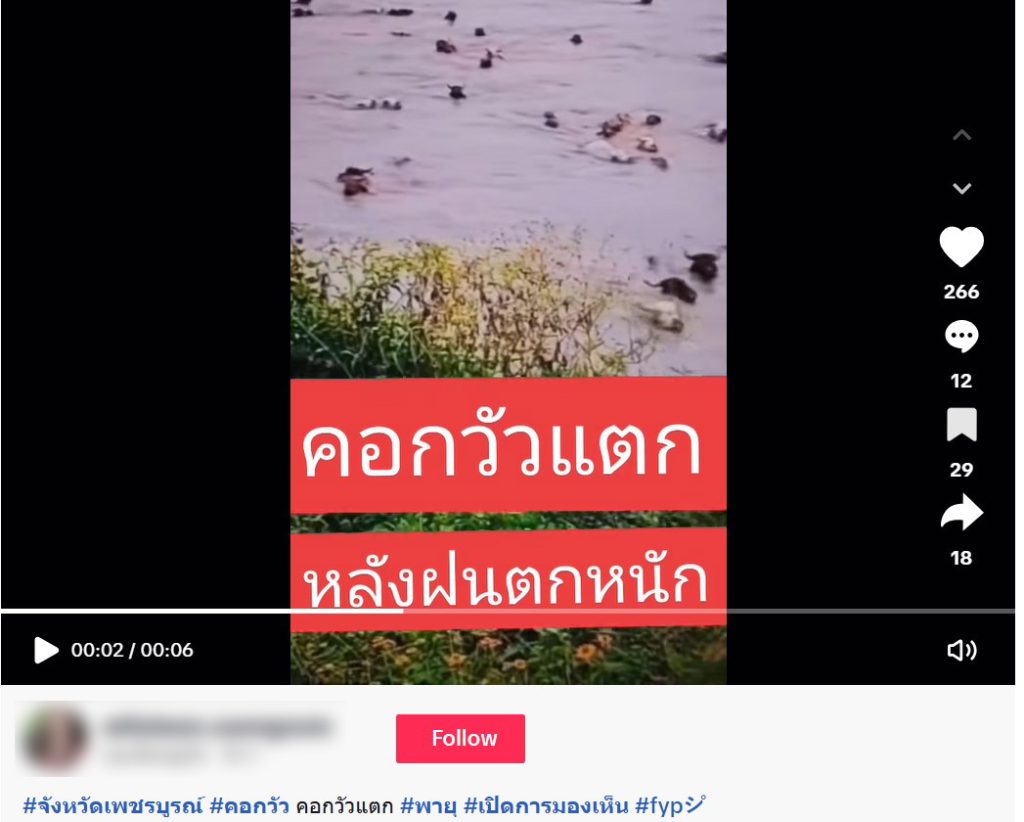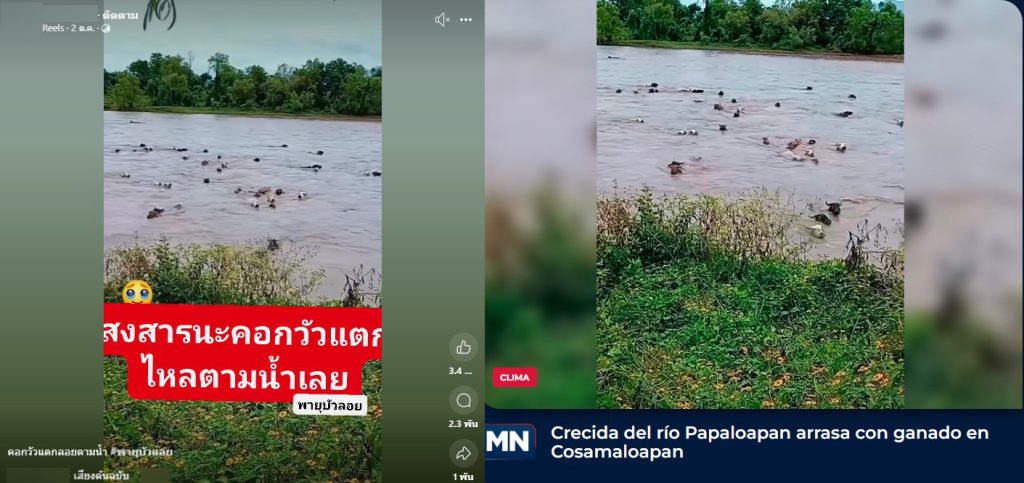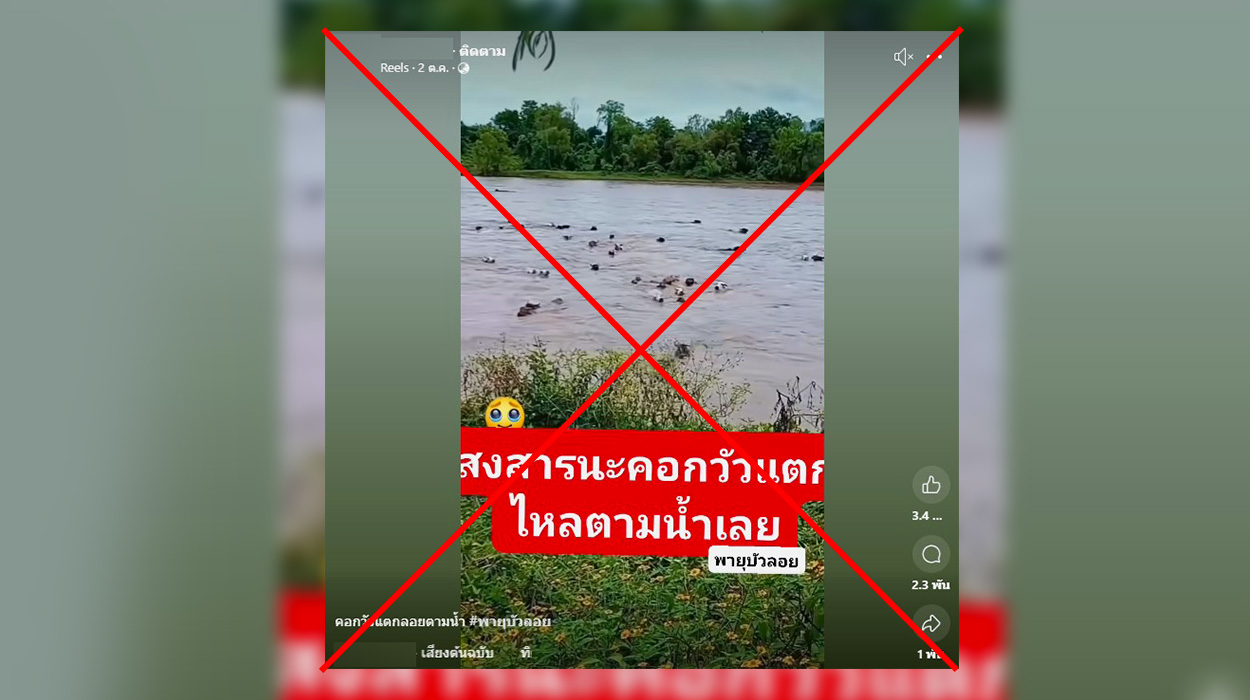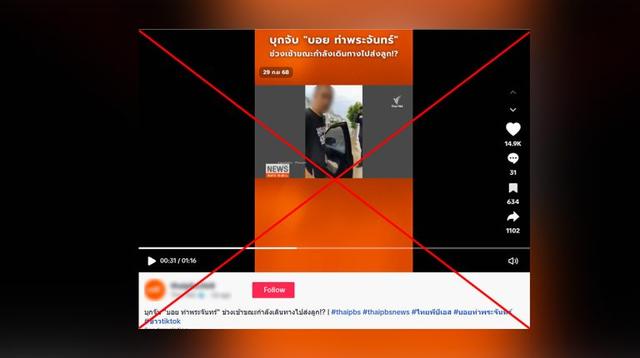Source of the fake news: TikTok

A TikTok account shared a video showing a large number of cows floating along with the floodwaters from Tropical Storm Bualoi.
Thai PBS Verify found that a TikTok account shared a video showing a large number of cows floating along with floodwaters from Tropical Storm Bualoi, with the caption: “#Phetchabun #Cowshed #CowshedCollapsed #Storm.”
The investigation revealed that the video had 266 views, 266 reactions, 12 comments, and over 18 shares. Most of the comments expressed sympathy for the incident and believed that the video showed cows swept away by the flood caused by Tropical Storm Bualoi in Thailand.
Verification tools confirmed the incident occurred in Mexico.
Thai PBS Verify used the InVID-WeVerify program to break the video into individual frames and then used Google Lens to verify the images. The results matched a news report titled “Creciente en río Papaloapan, en Veracruz, arrasa con el ganado de la zona; luchaban por ganarle a la corriente”, which translates to:
“The rising water in the Papaloapan River in Veracruz, Mexico swept away livestock in the area as they struggled against the current.” This report was published by Meganoticias on September 23, 2025.

Comparison of the cow-floating video from Reels (left) and the report by Meganoticias (right).
Department of Livestock confirms it’s fake news
Thai PBS Verify contacted the Phetchabun Provincial Livestock Office, which confirmed that the video showing several cows floating in floodwaters did not originate in Phetchabun Province. The office also stated that the flood situation in the province has already returned to normal.
Royal Irrigation Department reports stable water levels nationwide, reducing discharge to prepare for mid-October monsoon trough
Dr. Thanet Sombun, Director of the Office of Water Management and Hydrology, Royal Irrigation Department, stated that Thailand’s current water situation remains stable. The tropical storm “Matmo”, which had moved over northern Thailand, has weakened into a low-pressure system. However, residual effects of the storm are still present, though less widespread, resulting in an overall decrease in rainfall across the northern region — with occasional heavy rain in some areas.

Dr. Thanet Sombun, Director of the Office of Water Management and Hydrology, Royal Irrigation Department.
Meanwhile, the water levels in the country’s main dams — Bhumibol Dam and Sirikit Dam — are currently at 86% and 97% of capacity, respectively, which are considered manageable levels. The Royal Irrigation Department has adopted a policy to store as much water as possible and release as little as necessary to prevent impacts on the lower central region.
As for the country’s four main rivers — the Ping, Wang, Yom, and Nan Rivers — which converge in Nakhon Sawan Province, forming the “Sakae Krang Basin,” water levels are expected to decrease as rainfall lessens. The department has therefore increased water distribution into irrigation systems on both the eastern and western sides, following the Prime Minister’s directive. On the eastern side, for example, Pa Sak Jolasid Dam is currently receiving approximately 210–211 cubic meters of water per second into the system.
In addition, the Royal Irrigation Department has reduced water discharge from the Chao Phraya Dam from 2,500 to 2,400 cubic meters per second to ease the impact on downstream areas. This has resulted in water levels from Chainat Province downstream dropping by about 10–20 centimeters. Meanwhile, Pa Sak Jolasid Dam is also expected to further reduce its discharge, as water inflow has started to decline — consistent with the Prime Minister’s policy.
During flooding situations, a large volume of information often circulates online, some of which may be false or unverified. The public is advised to check information through official sources, such as the Meteorological Department for weather updates, the Hydro–Informatics Institute (HII) or the Royal Irrigation Department for water forecasts, and to follow updates through official websites and government communication channels for accurate information.
In addition, the Royal Irrigation Department has reduced water discharge from the Chao Phraya Dam from 2,500 to 2,400 cubic meters per second to ease the impact on downstream areas. This has resulted in water levels from Chainat Province downstream dropping by about 10–20 centimeters. Meanwhile, Pa Sak Jolasid Dam is also expected to further reduce its discharge, as water inflow has started to decline — consistent with the Prime Minister’s policy.
During flooding situations, a large volume of information often circulates online, some of which may be false or unverified. The public is advised to check information through official sources, such as the Meteorological Department for weather updates, the Hydro–Informatics Institute (HII) or the Royal Irrigation Department for water forecasts, and to follow updates through official websites and government communication channels for accurate information.
Authorities continue to closely monitor the situation, as after October 15, 2025, the monsoon trough is expected to shift southward across the central region, potentially bringing increased rainfall. The impact will depend on the intensity and volume of rain.
For Bangkok and surrounding areas, water is being continuously drained from the system through irrigation canals connected to the city to prepare for possible additional inflows. The waterways can currently handle the existing water volume, but residents living along riverbanks may experience temporary flooding or tidal surges in certain areas.
What’s the truth?
Thai PBS Verify examined the video circulating on Facebook Reels using the InVID–WeVerify program and Google Lens, and found that it was footage from an incident in Mexico, not Thailand.
The misleading clip caused many people to misunderstand the current water situation in Thailand. Meanwhile, the Phetchabun Provincial Livestock Office confirmed that the video is not real and did not occur in Thailand.












